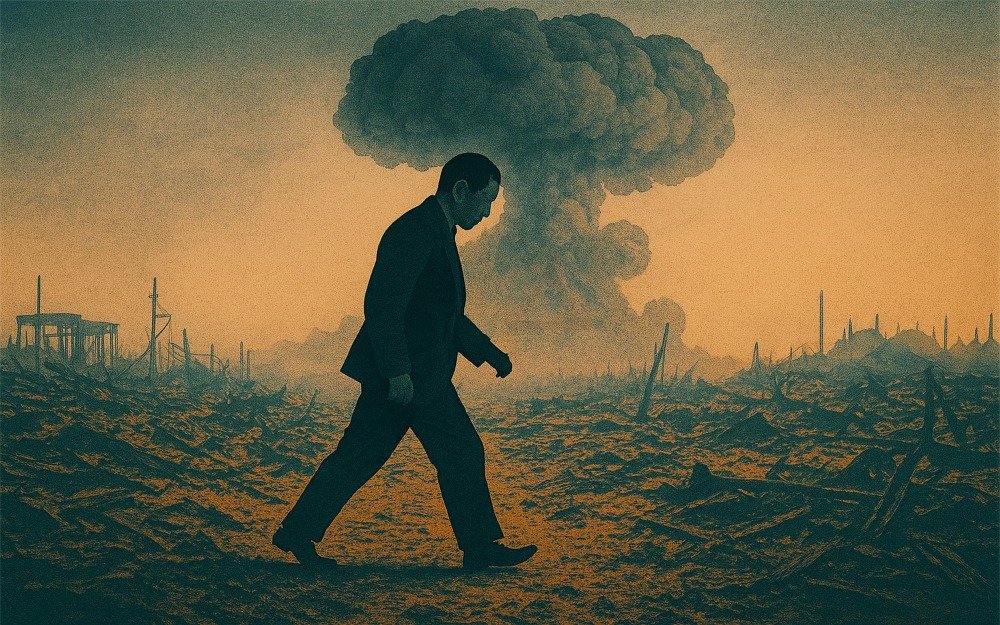
He was bombed twice and survived twice. Tsutomu Yamaguchi remains the only known human to have lived through both atomic bombings — Hiroshima on August 6, 1945, and Nagasaki three days later. His survival was real. The disbelief was universal.
Hiroshima: A Great Flash in the Sky
Yamaguchi was in Hiroshima on assignment for Mitsubishi Heavy Industries. He was a naval engineer who understood logistics, structure, and blast radius — at least in theory.
At 8:15 a.m., the Enola Gay dropped “Little Boy” when Yamaguchi was less than two kilometres from ground zero. The blast knocked him off his feet. He suffered burns, temporary blindness, and damage to his hearing.
Hiroshima had been flattened. The blast radius extended beyond comprehension. Somehow, Yamaguchi made his way to Hiroshima Station, where two colleagues who’d also survived the explosion — Akira Iwanaga and Kuniyoshi Sato — waited outside the heavily damaged terminal. The three spent the night in a bomb shelter and boarded a train bound for Nagasaki the following day. The rail system, though scorched and fractured, was functional in parts.
Yamaguchi did not reach Nagasaki until the evening of August 8, when he was finally able to dress his wounds and get some rest.
The Conversation Interrupted by a Bomb
Bandaged and burned, Yamaguchi reported for work on August 9. His supervisor asked him to account for his injuries. Yamaguchi described the Hiroshima blast — how the sky lit up, how the city had vanished. The supervisor dismissed him as delusional. No weapon could do what he described.
Then the second bomb, “Fat Boy”, detonated over Nagasaki.
The conversation ended abruptly as the office windows shattered. The city had been flattened. Nagasaki was later described as “a graveyard with not a tombstone standing.”
Yamaguchi had survived once again. His supervisor’s fate is unknown.
Timeline Echo
Location: Less than 2 km from ground zero; injured but mobile.
Note: Spent the night in a bomb shelter. Boarded a train to Nagasaki the following day.
Note: Travelled with two colleagues through damaged infrastructure and refugee corridors.
Note: Supervisor dismisses account as delusional. Minutes later, Nagasaki is bombed.
Note: Only person formally acknowledged to have survived both atomic bombings.
Radiation, Longevity, and the Limits of Planning
In 2009, the Japanese government officially acknowledged Tsutomu Yamaguchi’s presence at both bomb sites. He became a symbol of resilience, disbelief, and contradiction. He was no longer a metaphor. He was a man who’d walked through the ashes twice.
Tsutomu Yamaguchi and his wife both lived to 93 and both had cancer. Radiation may have played a role. It usually does. However, they lived longer than most of their generation, longer than many of the unbombed, and significantly longer than anyone expected.
Yamaguchi was an engineer. He understood blast radius, structural integrity, and survivability. But he couldn’t plan for disbelief, for being bombed twice, or for living through both. Some things resist calculation.
Survivor Statistics Echo
Immediate Deaths: Hiroshima: ~70,000–80,000 | Nagasaki: ~40,000–75,000
Note: Casualty estimates vary due to record loss, radiation effects, and post-blast injuries.
Official Recognition: Only Tsutomu Yamaguchi was formally acknowledged by the Japanese government.
Note: Recognition came in 2009—64 years after the bombings.
Note: Both died of cancer. Radiation may have played a role. Longevity certainly did.
Twice Bombed, Never Defined
He was called “the luckiest man alive.” He was also called “the unluckiest.” Both labels stuck. Neither explained him.
Yamaguchi didn’t escape the bombs. He absorbed them. He didn’t defy death. He delayed it.
His survival wasn’t miraculous. It was logistical. He was in the wrong place twice, and he survived twice.
Luck is a label. So is bad luck — neither label accounts for the ashes, disbelief, or longevity.
Think surviving two atomic bombs was improbable? It was. But not impossible. Explore more in our Uncanny Coincidences archive.
References:
[1] Wikipedia. “Tsutomu Yamaguchi.” Retrieved September 2, 2025, from Wikipedia — Tsutomu Yamaguchi
[2] History.com. “The Man Who Survived Two Atomic Bombs.” Retrieved September 2, 2025, from History.com — The Man Who Survived Two Atomic Bombs
[3] RNZ. “Tsutomu Yamaguchi: The man who survived both atomic bombs.” Retrieved September 2, 2025, from RNZ — Tsutomu Yamaguchi: The man who survived both atomic bombs
[4] The Guardian. “Japanese man confirmed as only person to survive both atomic bombs.” Retrieved September 2, 2025, from The Guardian — Japanese man confirmed as only person to survive both atomic bombs
[5] NHK World. “Double Hibakusha: Tsutomu Yamaguchi’s testimony.” Retrieved September 2, 2025, from NHK World — Double Hibakusha: Tsutomu Yamaguchi’s testimony
[6] History Skills. “Tsutomu Yamaguchi.” Retrieved September 2, 2025, from History Skills — Tsutomu Yamaguchi
[7] Smithsonian Magazine. “The Man Who Survived Two Atomic Bombs.” Retrieved September 2, 2025, from Smithsonian Magazine — The Man Who Survived Two Atomic Bombs
